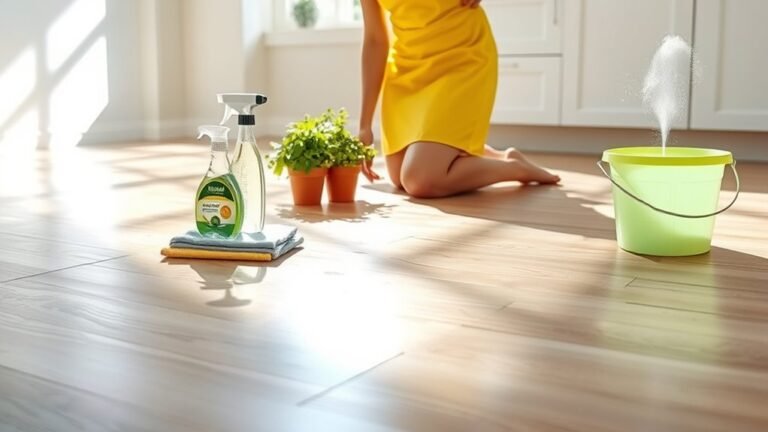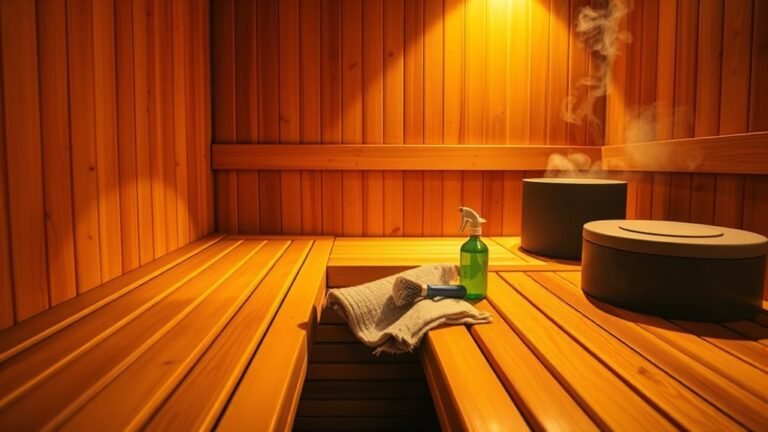Seasonal Maintenance Tips for Baby Items
You’ll want to prep your baby’s wardrobe with breathable, layered clothing to handle temperature swings comfortably. Regularly clean toys with gentle soap, storing them in labeled bins when not in use to keep things tidy. Check strollers and car seats for wear, clean fabrics carefully, and guarantee safe installation. Protect nursery furniture from moisture and damage with covers and humidity control. Organizing essentials by season and type saves time and stress. Keep these simple steps in mind, and you’ll find more ways to protect your baby’s items year-round.
Preparing Baby Clothing for Changing Weather

As the seasons shift, you’ll want to adjust your baby’s wardrobe to keep them comfortable and safe. Start by embracing layering techniques—these allow you to add or remove clothing easily as temperatures fluctuate. Choose breathable, natural fabric choices like cotton and bamboo; they regulate temperature and minimize skin irritation. Avoid synthetic materials that can trap heat or cause discomfort. Consider lightweight onesies for warm days, complemented by soft sweaters or jackets for cooler times. Pay attention to your baby’s cues—if they seem too warm or cold, adjust layers accordingly. This flexible approach not only protects your baby but also lets you enjoy the freedom of spontaneous outdoor adventures without worry. Thoughtful fabric and layering choices guarantee your little one stays cozy and happy throughout seasonal changes.
Cleaning and Storing Toys Between Seasons
Once your baby’s wardrobe is ready for the changing weather, it’s a good moment to turn your attention to their toys. Regularly cleaning toys not only keeps germs at bay but also guarantees your baby’s playtime remains safe and enjoyable. Effective toy sanitization methods include using mild soap and warm water, or a diluted vinegar solution for non-porous items. For electronic or fabric toys, check manufacturer guidelines to avoid damage. Once cleaned, seasonal toy storage is essential: choose breathable bins or labeled boxes to keep toys organized and protected from dust and moisture during off-seasons. This approach not only preserves your baby’s favorite items but also frees up space, helping you maintain a clutter-free environment that supports your family’s lifestyle and peace of mind.
Maintaining Strollers and Car Seats Year-Round

Although strollers and car seats are designed to endure daily use, regular maintenance is essential to guarantee your baby’s safety and comfort throughout the year. Check your stroller for worn wheels, loose screws, and functioning brakes to maintain stroller safety. Clean fabric and harnesses according to manufacturer instructions to prevent wear and allergens. For car seat installation, confirm the seat is correctly secured and hasn’t shifted, especially after seasonal temperature changes that can affect tightness. Inspect straps for fraying and buckles for proper locking. Avoid using harsh chemicals that could degrade materials. By staying proactive with these tasks, you’re confirming your child’s safety without feeling confined by constant worry. Maintaining your baby gear year-round lets you enjoy freedom knowing your essentials are secure and comfortable, no matter the season.
Protecting Nursery Furniture From Seasonal Damage
Since nursery furniture is often made from delicate materials like wood and fabric, it’s important to take steps to protect it from seasonal changes that can cause damage. Fluctuations in humidity can lead to wood warping or fabric mildew, so using humidity control devices like dehumidifiers or humidifiers helps maintain a stable environment. Additionally, investing in breathable furniture covers shields surfaces from dust, spills, and temperature shifts without trapping moisture. Regularly inspecting the furniture for signs of wear or damage allows you to address issues early, preserving both safety and appearance. By proactively managing humidity and using protective covers, you create a nurturing space where your baby’s furniture stays in great condition year-round, giving you peace of mind and freedom from unexpected repairs.
Organizing Baby Essentials for Seasonal Transitions

As the seasons change, you’ll need to adjust how you organize your baby’s essentials to keep everything accessible and appropriate for the weather. Effective baby gear organization helps reduce stress and saves time, while seasonal storage solutions protect items from damage and clutter.
| Item Type | Seasonal Storage Solution | Tips for Easy Access |
|---|---|---|
| Clothing | Vacuum-sealed bags | Label by size and season |
| Blankets | Airtight bins | Store near changing area |
| Outdoor Gear | Hooks or wall organizers | Keep by the door |
| Feeding Items | Clear plastic containers | Group by usage frequency |
Frequently Asked Questions
How Often Should I Replace My Baby’s Pacifiers?
You should replace your baby’s pacifiers every 4 to 6 weeks to guarantee ideal pacifier lifespan and maintain pacifier hygiene. Over time, wear and tear can create cracks that harbor bacteria, risking your little one’s health. Also, anytime the pacifier shows visible damage or changes in texture, swap it out immediately. Keeping pacifiers clean and replacing them regularly supports your baby’s safety while giving you peace of mind.
What Are the Best Materials for Baby Blankets in Winter?
When choosing baby blankets for winter, you’ll want materials that keep your little one warm without overheating. Cotton blankets are breathable and gentle on sensitive skin, making them a great natural choice. Fleece blankets, on the other hand, are excellent for extra warmth and softness. You might prefer cotton for layering and fleece for chilly nights. Either way, both materials offer cozy comfort, so your baby stays safe and snug throughout the season.
Can I Use Essential Oils Safely Around My Baby?
When considering essential oil safety around your baby, you’ve got to be cautious. Babies have delicate respiratory systems and sensitive skin, so many oils can cause irritation or allergic reactions. To protect baby health, always dilute oils heavily, avoid direct skin contact, and never diffuse in small, unventilated spaces. Consult a pediatrician for guidance. Using essential oils safely means balancing your freedom to use them with the responsibility of keeping your little one safe.
How Do I Sanitize Baby Bottles Effectively?
They say, “An ounce of prevention is worth a pound of cure.” To sanitize baby bottles effectively, you can use bottle sterilization methods like boiling, steam sterilizers, or microwave sterilizers. After cleaning, make sure to dry bottles completely and practice safe bottle storage by keeping them in a clean, sealed container. This helps protect your baby from germs while giving you peace of mind to enjoy the freedom that comes with proper hygiene.
What Are Signs of Outgrown Baby Shoes?
You’ll know your baby’s shoes are outgrown when you notice tightness around the toes or the shoes feel cramped. Check for signs like redness or marks on their feet after wearing them. Proper baby shoe sizes are essential because cramped shoes can hinder foot development. Always leave about a thumb’s width of space for growth. If your little one frequently trips or seems uncomfortable, it’s time to size up to support healthy, happy feet.






